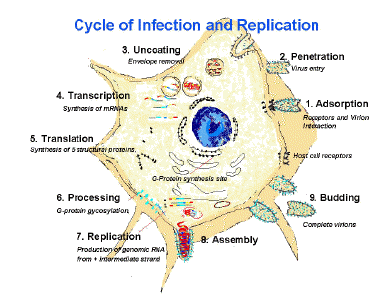Rabies
Rabies virus is a nonsegmented, negative-stranded RNA virus in a bullet shaped envelope with transmembrane, trimeric spike-like glycoprotien peplomers covering its surface (CDC,2011; Consales and Bolzan, 2006; Smith,1996). It is a Lyssavirus that is one of the seven genera that make up the Rhabdoviridae family in the Mononegavirale order (CDC,2011; Consales and Bolzan, 2006; Drs. Foster and Smith, 1997-2015; Smith,1996). Lyssavirus includes: classical rabies virus (RABV; genotype 1), Mokola virus (MKV; genotype 3), Lagos bat virus (LBV; genotype 2), Duvenhage virus (DV; genotype 4), Australian bat lyssavirus (ABLV; genotype 7), and European bat lyssavirus 1 (EBLV-1; genotype 5), European bat lyssavirus 2 (EBLV-2; genotype 6) (CDC,2011; Consales and Bolzan, 2006; Smith,1996).

Image available from: https://dokuwiki.noctrl.edu/doku.php?id=bio:440:rabies
The virus's genome consists of a leader sequence and five monocistronic genes that code for five viral proteins (CDC,2011; Consales and Bolzan, 2006).The N protein is a nucleoprotein that encapsulates the genomic RNA and is coded by the N gene (CDC,2011; Consales and Bolzan, 2006). The P gene codes for the phosphoprotein which is associated with the ribonucleoprotein core (RNP) and isimportant for transcription, replication, and interactions with cellular protein components during axoplasmic transport (CDC,2011; Consales and Bolzan, 2006). The matrix protein is coded by the M gene could possibly be the central protein of rhabdovirus assembly and is associated with the envelope and the RNP(CDC,2011; Consales and Bolzan, 2006). The G gene codes for the glycoprotein that forms the trimeric spike on the surface of the virus (CDC,2011; Consales and Bolzan, 2006). The polymerase for RNA synthesis is the Lprotein which is coded by the L gene and associated with the RNP (CDC,2011; Consales and Bolzan, 2006).
Transmition of the virus is most commonly through a bite or scratch but few reported cases of infection resulting from aerosolization occurring in caves where large quantities of infected bats live and accidentally in laboratories have ooccured (Consales and Bolzan, 2006; Drs. Foster and Smith, 1997-2015). There have also been reports of infection through the digestive tract (Consales and Bolzan, 2006). The virus enters the host through wounds and/or direct contact with mucosal surfaces but can not cross intact skin (Consales and Bolzan, 2006). The rabies virus can not survive long outside of a host and only stays viable in the carcass of an infected animal for less than 24hours (Drs. Foster and Smith, 1997-2015).
It can infect all warm-blooded animals, but some animals are more resistant to the virrus than others (Consales and Bolzan, 2006; Drs. Foster and Smith, 1997- 2015). Humanes, dogs and cats are considered mildly susceptible with only about 15% of people exposed to the virus contracting the disease (Drs. Foster and Smith, 1997- 2015)..

Image available from: http://www.cdc.gov/rabies/transmission/virus.html
The incubation period varies depending on species and location of the bite and amount of viral inoculaum that enters the bite (Consales and Bolzan, 2006; Drs. Foster and Smith, 1997- 2015).Once the viruse reaches the brain the host will go through one,tow, or all three of the differents phases of infection (Consales and Bolzan, 2006; Drs. Foster and Smith, 1997- 2015). The first phase is the prodromal phase. Durring this phase the host may run a fever as well as become anxious, nervous and apprehensive (Drs. Foster and Smith, 1997- 2015). the next phase is the acute neurological (or furious) phase (Consales and Bolzan, 2006; Drs. Foster and Smith, 1997- 2015). In this stage the host may become irritable and restless along with developing a hypersensitivity to sights, sounds and smells (Drs. Foster and Smith, 1997- 2015). Hallucinations, convulsive and nonconvulsive seizures, and Hener’s vertigo syndrome are also common in this phase (Consales and Bolzan, 2006).
The hird phase is the paralytic (or coma) phase. Durring this phase affcted nerves cause paralysis untill the host's entier body is paralized and the host goes into a coma (Consales and Bolzan, 2006; Drs. Foster and Smith, 1997- 2015).. Circulatory insufficiency durring this stage is the prime cause of death (Consales and Bolzan, 2006; Drs. Foster and Smith, 1997- 2015).
For information on the prevention of rabies click here.
References:
-
Cdc.gov; Center for Disease Control and Prevention; 2011 [cited December 1, 2015] Available from: http://www.cdc.gov/rabies/transmission/virus.html
-
Consales CA, Bolzan VL. RABIES REVIEW: IMMUNOPATHOLOGY, CLINICAL ASPECTS AND TREATMENT. J. Venom. Anim. Toxins incl. Trop. Dis. 2007; 13(1): 5-38.
-
Smith JS. New Aspects of Rabies with Emphasis on Epidemiology, Diagnosis, and Prevention of the Disease in the United States. CLINICAL MICROBIOLOGY REVIEWS. 1996; 9(2): 166-176.
-
Drs. Forrest and Smith. Rabies in Dogs: Symptoms, Diagnosis, Treatment & Vaccination. c1997-2015. Available from: http://www.peteducation.com/article.cfm?c=2+2102&aid=347